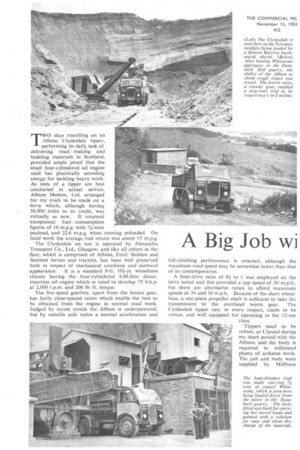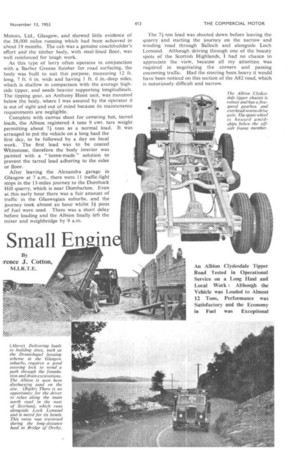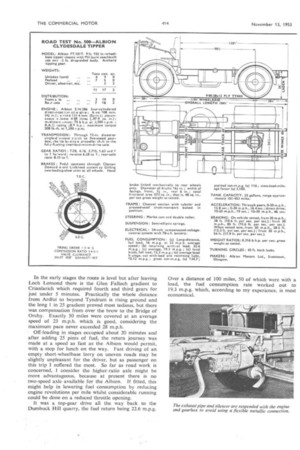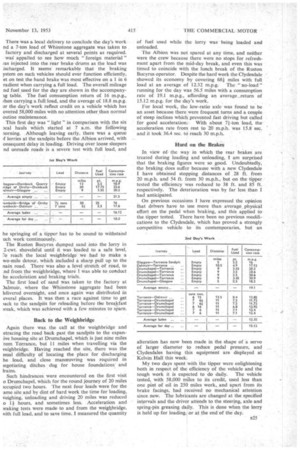A Big Job wi Small En in
Page 124

Page 125

Page 126

Page 131

If you've noticed an error in this article please click here to report it so we can fix it.
By
rence J. Cotton,
M.I.R.T.E. TWO days travelling on an Albion Clydesdale tipper, performing its daily task of delivering road making and building materials in Scotland, provided ample proof that the small four-cylindered oil engine used has practically unending energy for tackling heavy work. As tests of a tipper are best conducted in actual service, Albion Motors, Ltd. arranged for my trials to be made on a lorry which, although having 58,000 miles to its credit, was virtually as new. It returned exceptional fuel consumption figures of 16 m.p.g. with 7i-tons payload, and 22.6 m.p.g. when running unloaded. On local work the average fuel return was about 15 m.p.g.
The Clydesdale on test is operated by Alexandra Transport Co., Ltd., Glasgow, and like all others in the fleet, which is comprised of Albion, Ford, Seddon and Sentinel lorries and tractors, has been well preserved both in respect of mechanical condition and outward appearance. It is a standard 9-ft, 101-in. wheelbase chassis having the four-cylindered 4.88-litre directinjection oil engine which is rated to develop 75 b.h.p. at 2,000 r.p.m. and 208 lb.-ft. torque.
The five-speed gearbox, apart from the lowest gear, ha-s fairly close-spaced ratios which enable the best to be obtained from the engine in normal road work. Judged by recent trends the Albion is underpowered, but by suitable axle ratios a normal acceleration and hill-climbing performance is retained, although the maximum road speed may be somewhat lower than that of its contemporaries.
A final-drive ratio of 8i to 1 was employed on the lorry tested and this provided a top speed of 30 m.p.h., but there are alternative ratios to afford maximum speeds of 34 and 38 m.p.h. Because of the short wheelbase, a one-piece propeller shaft is sufficient to take the transmission to the overhead worm gear. The Clydesdale tipper can, in every respect, claim to be robust, and well equipped for operating in the 12-ton class.
Tippers need to be robust, as I found during my short period with the Albion, and the body is required to withstand plenty of arduous work. The cab and body were supplied by Millburn Motors, Ltd., Glasgow, and showed little evidence of the 58,000 miles running which had been achieved in about 19 months, The cab was a genuine coachbuilder's effort and the timber body, with steel-lined floor, was well reinforced for tough work.
As this type of lorry often operates in conjunction with a Barber Greene finisher for road surfacing, the body was built to suit this purpose, measuring 12 ft. long, 7 ft. 6 in. wide and having 1 ft. 6 in.-deep sides, which is shallow in comparison with the average highside tipper, and needs heavier supporting longitudinals. The tipping gear, an Anthony Hoist unit, was mounted below the body, where I was assured by the operator it is out of sight and out of mind because its maintenance requirements are negligible.
Complete with canvas sheet for covering hot, tarred loads, the Albion registered 4 tons 9 cwt. tare weight permitting about 71 tons as a normal load. It was arranged to put the vehicle on a long haul the first day, to be followed by a day on local work. The first load was to be coated Whinstone, therefore the body interior was painted with a " home-made " solution to prevent the tarred load adhering to the sides or floor.
After leaving the Alexandra garage in Glasgow at 7 a.m., there were 11 traffic-light stops in the 13-miles journey to the Dumbuck Hill quarry, which is near Dumbarton. Even at this early hour there was a fair amount of traffic in the Glaswegian suburbs, and the journey took almost an hour whilst 51 pints of fuel were used. There was a short delay before loading and the Albion finally left the mixer and weighbridge by 9 am.
The 71-ton load was sheeted down before leaving the quarry and starting the journey on the narrow and winding road through Balloch and alongside Loch Lomond. Although driving through one of the beauty spots of the Scottish Highlands, I had no chance to appreciate the view, because all my attention was required in negotiating the corners and passing oncoming traffic. Had the steering been heavy it would have been noticed on this section of the A82 road, which is notoriously difficult and narrow.
In the early stages the route is level but after leaving Loch Lomond there is the Glen Falloch gradient to Crianlarich which required fourth and third gears for just under 5 minutes. Practically the whole distance from Ardlui to beyond Tyndrum is rising ground and the long 1 in 25 gradient proved most tedious, but there was compensation from over the brow to the Bridge of Orchy. Exactly 50 miles were covered at an average speed of 23 m.p.h. which is good, considering the maximum pace never exceeded 28 m.p.h.
• Off-loading in stages occupied about 20 minutes and .after adding 25 pints of fuel, the return journey was made at a speed as fast as the Albion would permit, with a stop for lunch on the way. Fast driving of an empty short-wheelbase lorry on uneven roads may be slightly unpleasant for the driver, but as passenger on this trip I suffered the most. So far as road work is concerned, I consider the higher-ratio axle might be more advantageous, because at present there is no two-speed axle available for the Albion. If fitted, this might help in lowering fuel consumption by reducing engine revolutions per mile whilst considerable running could be done on a reduced throttle opening.
It was a top-gear drive all the way back to the Dumbuck Hill quarry, the fuel return being 22.6 m.p.g. Over a distance of 100 miles, 50 of which were with a load, the fuel consumption rate worked out to 19.3 m.p.g. which, according to my experience, is most economical.
There was a local delivery to conclude the day's work nd a 7-ton load of Whinstone aggregate was taken to factory and discharged at several points as required. wag appalled to see how much "foreign material" tas injected into the rear brake drums as the load was ischarged. It seems remarkable that the braking ystern on such vehicles should ever function efficiently, et on test the hand brake was most effective on a 1 in '6 radient when carrying a full load. The overall mileage nd fuel used for the day are shown in the accompany1.g table. The fuel consumption return of 16 m.p.g., 'hen carrying a full load, and the average of 18.8 m.p.g. or the day's work reflect credit on a vehicle which has oVered 58,000 miles with no attention other than normal outine maintenance.
This first day was " light " in bomparison with the six 3cal hauls which started at 7 a.m. the following lorning. Although leaving early, there was a queue I lorries at the sandpits before the Albion arrived, with onsequent delay in loading. Driving over loose sleepers nd unmade roads is a severe test with full load, and he springing of a tipper has to be sound' to withstand uch work continuously.
The Ruston Bucyrus dumped sand into the lorry in 2-cwt. shovelsfiil until it was loaded to a safe level. Co reach the local weighbridge we had to make -a wo-mile detour, which included a sharp pull up to the nain road. There was also a level stretch of road, to .nd from the weighbridge, where I was able to conduct he acceleration and braking trials.
The firstioad of sand was taken to the factory at )almair, where the Whinstone aggregate had been lelivered overnight, and once again was distributed in everal places. It was then a race against time to get )ack to the sandpits for reloading before the breakfast n-eak, which was achieved with a few minutes to spare.
Back to the Weighbridge Again there was the call at the weighbridge and etracing the road back past the sandpits to the expanive housing site at Drumchapel, which is just nine miles torn Torrance, but 11 miles when travelling via the veighbridge. Having reached the site, there was the isual difficulty of locating the place for discharging he load, and close manceuvring was required in legotiating ditches dug for house foundations. and 'rains.
Such hindrances were encountered on the first visit o Drumehapel, which for the round journey of 20 miles )ccupied two hours. The next four loads were for the ame site and by dint of hard work the time for loading, Veighing, unloading and driving 20 miles was reduced o 11 hours, and sometimes less. Acceleration and 'raking tests were made to and from the weighbridge, vith full load, and to save time. I measured the quantity The Albion was not spared at any time, and neither were the crew because there were no stops for refreshment apart from the mid-day break, and even this was timed to coincide with the lunch break of the Ruston Bucyrus operator. Despite the hard work the Clydesdale showed its economy by covering 681 miles with full load at an average of 12.32 m.p.g. The " no-load " running for the day was 56.5 miles with a consumption rate of 19.1 m.p.g., affording an average __return of 15.12 m.p.g. for the day's work.
For local work, the low-ratio axle was found to be an asset because there were frequent turns and a couple of steep inclines which prevented fast driving but called for good acceleration,. With about 7/-ton load, the acceleration rate from rest to 20 m.p.h. was 15.8 sec. and it took 36.4 sec. to reach 30 m.p.h.
Hard on the Brakes In view of the way in which the rear brakes are treated during loading and unloading, I am surprised that the braking figures were so good. Undoubtedly, the braking does sutler because with a new Clydesdale
I have obtained stopping distances of 28 ft. from 20 m.p.h. and 54 ft. from 30 m.p.h., but on the tipper tested the efficiency was reduced to 38 ft. and 85 ft. respectively. The deterioration was by far less than I had anticipated.
On previous occasions I have expressed the opinion that drivers have to use more than average physical effort on the pedal when braking, and this applied to the tipper tested. There have been no previous modifications to the Clydesdale, which has proved a strongly competitive vehicle to its contemporaries, but an alteration has now been made in the shape of a servo of larger diameter to reduce pedal pressure, and Clydesdales having this equipment are displayed at Kelvin Hall this week.
My two days spent with the tipper were enlightening both in respect of the efficiency of the vehicle and the tough work it is expected to do daily. The vehicle tested, with 58,000 miles to its credit, used less than one pint of oil in 250 miles work, and apart from its brake facings, had received no mechanical attention since new. The lubricants are changed at the specified intervals and the driver attends to the steering, axle and spring-pin greasing daily. This is done when the lorry is held up for loading, or at the end of the day.












































































































































































































































